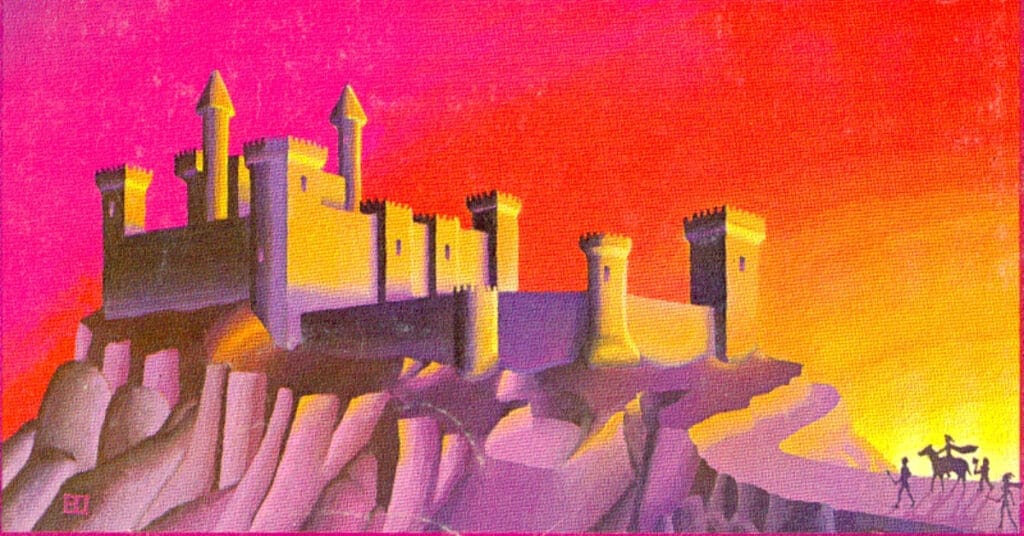Last Updated on November 16, 2023
“The realm of mankind is narrow and constricted. Always, the forces of Chaos press upon its borders”.
Here, at the ragged edge of civilization, stands the last bastion that remains between the human lands and the chaotic, monstrous wilderness: The Keep on the Borderlands.
Published in 1979, module B2 Keep on the Borderlands was one of the very first adventures written for Dungeons & Dragons by the game’s co-creator Gary Gygax himself.
Table of Contents
Keep on the Borderlands 5th Edition
If you want to run Keep on the Borderlands using 5e, you have three options.
If you go with either of the first two, however, you may have to prepare your players for the idea that the adventure may not be anything remotely near “balanced.”
- Convert it yourself, which is totally doable if you’re comfortable rebalancing encounters on the fly and can improvise a monster stat block, spell effect, or magic item on short notice.
- If you want a real bare-bones conversion that keeps everything but the ruleset the same, there are a few like this one on DM’s Guild. Fair warning: I’ve not had a chance to read through any of them, so your mileage may vary.
- Lastly, if you want a curated, 5e-focused (admittedly expensive) adventure and campaign in the fabled Borderlands, check out Into the Borderlands by Goodman Games. It’s a weighty homage to the original module, reimagined and expanded — kind of like the relationship between Curse of Strahd and I6 Ravenloft.
Where Can I Find Different Versions of The Keep on the Borderlands?
If you’re interested in this module, the pdf and a print-on-demand copy of middling quality are both available from Drive Thru RPG and the DM’s Guild for around $5 and $15, respectively.
If you just want to get your hands on the broad strokes of the module or just feel like reading it for inspiration, this is your best bet.
If you really like it, the sheer popularity and number of print runs this adventure had actually make it one of the cheapest to buy secondhand when other rarer adventures from the time period can go for serious money.
You can also pick up a pdf copy of the Tom Moldvay edition of D&D Basic edition from the DM’s Guild if you want to get an idea of the (much simpler) rules that the system uses.
That being said, Keep on the Borderlands does provide a reasonable rules recap of Basic D&D itself — the legacy of a time when all rules weren’t readily available on the internet at a moment’s notice.
If you’re interested in giving old-school D&D a go (and, if you are, this is the module to start with) however, I would recommend checking out Old School Essentials Classic Fantasy by Necrotic Gnome, which is a reformatted and updated republishing of the Basic/Expert D&D rules in a much prettier package and has become the gold standard for the old-school dungeon-delving community in recent years.
Notes for the Dungeon Master
Not only was Keep on the Borderlands included in the D&D Basic boxed set from 1979–1982, making it many people’s first foray into the game, but the adventure has been revisited, remixed, and replayed so many times throughout subsequent editions of D&D that it can probably lay claim to the title of “most played D&D adventure ever.”
At its core, Keep on the Borderlands is a “teaching adventure.”
It’s designed to get new players used to sandbox-adventuring, dungeon-delving, and the quintessentially old-school D&D experience of being ignominiously torn apart and devoured by goblins.
Unlike 5e’s starter adventure Lost Mines of Phandelver, this module doesn’t present a series of encounters, a plot-evolving named NPCs, or even any real concrete details about a setting at all.
It’s a thoroughly agnostic piece of design that gives dungeon masters the freedom to make Keep on the Borderlands fit easily into their own homebrew campaign setting with ease and also challenges them to start making decisions about their own game world.
However, Gygax doesn’t leave the task of preparing the borderlands for the arrival of adventurers entirely up to the DM.
The module also provides a lot of direct advice on how to run a campaign, much (not all) of which holds up more than 40 years later. The module itself claims that the keep presents “a microcosm, a world in miniature.” In many ways, I think, Keep on the Borderlands presents the whole of Dungeons & Dragons in miniature — at least, a certain style of D&D.

I played my first tabletop RPG (Pathfinder 1e, specifically) in college. I rocked up late to the first session with an unread rulebook and a human bard called Nick Jugger. It was a rocky start but I had a blast and now, the better part of a decade later, I play, write, and write about tabletop RPGs (mostly 5e, but also PBtA, Forged in the Dark and OSR) games for a living, which is wild.
